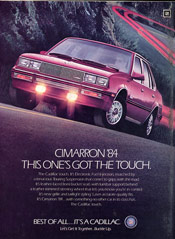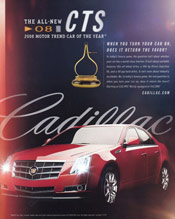Be Sure to Support the Life of Your Brand
Donovan Cronkhite
President, RJM
Posted On October 29, 2012
I am an unabashed car enthusiast just as likely to quote horsepower numbers from the 1960s as I am to talk about advertising. As a graphic designer, cars provide an endless supply of inspiration in color, attitude and shape. Every one has the same goal, but each gets you there in a slightly different manner. They're also a wonderful study in branding. Each manufacturer crafts their own brand, sometimes many under the same company. Miss the target market though, and you're out millions of dollars. Talk about a lot riding on a brand - entire factories are built on the hope that it appeals to the market.
We often say brands are timeless; and then in the same sentence turn around and say to make sure you're doing everything you can to protect yours so that it will last forever. Aren't those conflicting statements? How can a brand end if it's timeless? Fortunately, we don't have to look much farther than our garage to see how that can happen, and see one of the great brand saves in America.
 Since the beginning of the Cadillac brand they were known for luxury. In the 1950s and 1960s it was hard to buy a car more plush than an Eldorado or Coupe de Ville. Even in 1908, their marketing slogan was "Standard of the World." It's hard to argue with that - or the fins, twenty-foot long cars, leather interiors and powerful V8 motors that pushed them down the road. For years, if you rolled down the street in a Cadillac, you were a picture of success.
Since the beginning of the Cadillac brand they were known for luxury. In the 1950s and 1960s it was hard to buy a car more plush than an Eldorado or Coupe de Ville. Even in 1908, their marketing slogan was "Standard of the World." It's hard to argue with that - or the fins, twenty-foot long cars, leather interiors and powerful V8 motors that pushed them down the road. For years, if you rolled down the street in a Cadillac, you were a picture of success.
Then came the late 1970s. There's a lot about the late '70s that many people would like to forget, but I'm sure that the gas crunch would be right up there for Cadillac. The gas crisis put many of the American manufacturers in a tight spot, having been building ever larger and hungry cars, right as a slew of foreign manufacturers began to take hold. Suddenly, not only could a person purchase an equally luxurious car as a Cadillac, they could get one that got better gas mileage as well.
Instead of protecting their brand pillars - luxury and power - Cadillac responded to what they thought the consumer wanted. And they responded with the Cimarron. You might not remember the Cimarron. Many would like to forget it. But you probably remember it by another name - the Chevy Cavalier. For a few years, the Cadillac brand could entice people to buy a Cimarron. Younger people did buy it. But one quarter of former Cadillac buyers abandoned the brand. The brand value was destroyed by a product that didn't uphold the brand. In a short time, a brand with over 100 years of value they had worked so hard to uphold lost it all.
Products must uphold the brand image. Sure, advertising and marketing can shift brand perception to some degree, but people can tell if your product is inferior to the brand (or vice versa). One must work with the other. In 1999, Cadillac released the Escalade triggering the climb back. Big, powerful, luxurious, filled with leather and electronics, the Escalade supported the brand. Then in 2003, Cadillac, after having watched the storied GM brand Oldsmobile be disbanded, released the CTS.
 Full of sharp angles, the CTS didn't necessarily look like a Cadillac. But it was rear wheel drive. It offered a manual transmission. It was built in America. It was powerful. It was cool. It was nominated for car of the year. The marketing tagline was, "When you turn your car on, does it return the favor?" Appealing to the younger generation with the marketing; appealing to the older generation with the product and the brand. It was a marriage made in heaven.
Full of sharp angles, the CTS didn't necessarily look like a Cadillac. But it was rear wheel drive. It offered a manual transmission. It was built in America. It was powerful. It was cool. It was nominated for car of the year. The marketing tagline was, "When you turn your car on, does it return the favor?" Appealing to the younger generation with the marketing; appealing to the older generation with the product and the brand. It was a marriage made in heaven.
Brands are timeless. Supported by the right product and the right marketing, the basis of a brand can live forever. There is no doubt that the brand image for Cadillac is still luxury. Ask for a cloth interior in a Cadillac and see how far you get. But the company has worked hard to develop a brand perception and matching product that now also supports performance and energy. While the Cimarron almost killed the brand (and it wasn't the only factor), the new product line has reached into the past to tap the assets that it worked over 100 years to develop and bring forth a stronger brand than ever.
